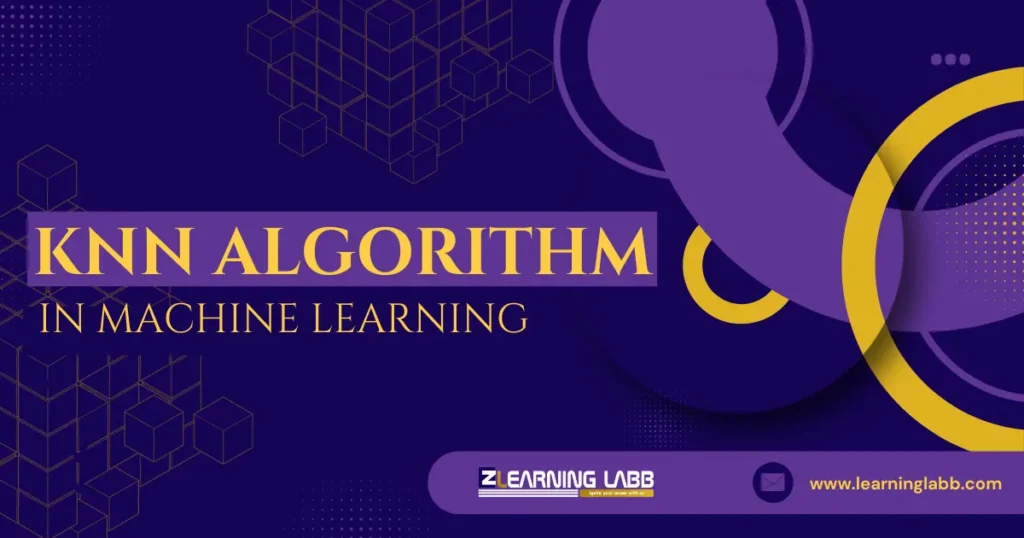What Is K Nearest Neighbor Algorithm in Machine Learning: Machine learning is transforming the way we solve real-world problems. From recommending products on Amazon to identifying diseases in medical imaging, machine learning algorithms play a crucial role. One of the simplest and most widely used algorithms in this space is the K Nearest Neighbor (kNN) algorithm in machine learning.
But what is K nearest neighbor algorithm in machine learning, and why is it important? In simple terms, kNN is a classification and regression algorithm that assigns a label to a new data point based on the most common labels of its nearest neighbors. It mimics how humans classify objects—by comparing them to known examples.
kNN is a non-parametric, instance-based learning algorithm that makes decisions based on similarity rather than building a predictive model.
In this blog, we will discuss:
- What is K nearest neighbor algorithm in machine learning
- How the kNN algorithm works
- Examples of kNN in real-world applications
- Advantages and disadvantages of kNN
- How to improve kNN for better results
- Learning kNN and machine learning with Ze Learning Labb (ZELL)
Let’s learn all about K Nearest Neighbor Algorithm in Machine Learning (kNN) and learn What is k nearest neighbor algorithm in machine learning…

What is K Nearest Neighbor Algorithm in Machine Learning?
The K Nearest Neighbor (kNN) algorithm in machine learning is a supervised learning algorithm that can be used for classification and regression. Unlike algorithms that build complex models, kNN simply stores all data points and makes decisions when a new input arrives.
Key characteristics of kNN:
- Instance-based learning: Instead of learning a model, kNN stores all training examples and classifies new data based on similarity.
- Lazy learning: The algorithm does not perform computations until a prediction is required.
- Non-parametric: It does not make any assumptions about how data is distributed.
- Versatile: kNN can handle classification (categorizing data) and regression (predicting numerical values).
Real-life example of kNN:
Imagine you enter a new coffee shop and want to decide what to order. You see customers enjoying cappuccinos and lattes. You decide to order what the majority is having—this is how kNN works!
Read more: Loss Functions In Deep Learning: Types, Purpose, And More
How Does kNN Algorithm Work?
Now that you know what is K nearest neighbor algorithm in machine learning, let’s learn about the kNN algorithm in machine learning follows a straightforward approach:
Step-by-step working of kNN algorithm:
- Choose the value of K – Select the number of nearest neighbors (K). If K=3, the algorithm will consider the three closest points.
- Calculate distance between points – Use distance metrics like Euclidean Distance or Manhattan Distance to measure similarity.
- Find the nearest neighbors – Identify the closest K data points in the dataset.
- Assign a class (for classification) – The most common class among the nearest neighbors determines the label of the new data point.
- Predict a value (for regression) – If kNN is used for regression, it takes the average of the nearest neighbors’ values.
Example of how kNN works:
Let’s say we have a dataset of students’ study hours and their exam results (Pass/Fail). A new student studies 6 hours, and we want to predict whether they will pass.
| Study Hours | Outcome |
| 2 | Fail |
| 3 | Fail |
| 5 | Pass |
| 7 | Pass |
| 8 | Pass |
If K=3, the algorithm will look at the three nearest study hours (5, 7, 8). Since the majority outcome is “Pass”, the new student is predicted to pass.
kNN’s strength lies in its simplicity—it classifies data based on similarity without building a complex model.
K Nearest Neighbor Classification in Machine Learning
One of the primary uses of kNN is classification—assigning a label to new data based on its closest examples.
Types of distance metrics in kNN classification:
- Euclidean distance – The most commonly used metric, measuring the straight-line distance between points.
- Manhattan distance – The sum of absolute differences between coordinates (useful for grid-like data).
- Minkowski distance – A generalization of Euclidean and Manhattan distance.
Example of kNN Classification:
A bank wants to classify loan applicants as High Risk or Low Risk based on their income and credit score. When a new applicant applies, kNN compares their details with existing customers and classifies them accordingly.
kNN is widely used in fraud detection, text classification, and recommendation systems.
K Nearest Neighbor Algorithm Example in Real Life
The K nearest neighbor applications span multiple industries:
Real-life uses of kNN algorithm:
- Healthcare – Predicting diseases based on patient symptoms.
- Finance – Identifying fraudulent transactions.
- E-commerce – Recommending products based on customer behavior.
- Social Media – Suggesting friends based on mutual connections.
- Image Recognition – Classifying objects in images.
Case study: kNN in healthcare
A hospital uses kNN to diagnose patients with diabetes based on attributes like glucose levels, BMI, and age. By comparing a new patient’s data with past cases, kNN predicts whether they are likely to have diabetes.
Continue learning about what is k nearest neighbor algorithm in machine learning…

Advantages and Disadvantages of kNN Algorithm
Advantages:
- Simple to implement and understand.
- Does not require training—works instantly.
- Works well with multi-class classification.
Disadvantages:
- Slow for large datasets.
- Sensitive to irrelevant features.
- Requires an optimal K value for accuracy.
How to Improve the kNN Algorithm?
To make kNN more efficient:
- Feature scaling – Normalize data using Min-Max Scaling or Z-score Normalisation.
- Dimensionality reduction – Use PCA (Principal Component Analysis) to remove unnecessary features.
- Choosing the right K value – Use cross-validation to select the best K.
Learn kNN and Machine Learning with Ze Learning Labb (ZELL)
Want to master data science, data analytics, or digital marketing? Ze Learning Labb (ZELL) offers hands-on courses:
- Data Science Course – Learn machine learning algorithms, including kNN.
- Data Analytics Course – Master data visualization and statistical analysis.
- Digital Marketing Course – Apply data-driven marketing techniques.
Start your career in data science with ZELL today!
On A Final Note…
Now that you understand what is K nearest neighbor algorithm in machine learning, you can see why it’s widely used for classification and regression tasks. Though simple, kNN algorithm in machine learning is a powerful tool for real-world applications.
To learn more, reach to us today!





